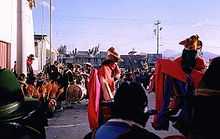Inti Raymi



The Inti Raymi ("Festival of the Sun")[1] was a religious ceremony of the Inca Empire in honor of the god Inti, one of the most venerated deities in Inca religion. It was the celebration of the Winter Solstice - the shortest day of the year in terms of the time between sunrise and sunset and the Inca New Year. In territories south of the equator the gregorian months of June and July are winter months.
During the Inca Empire, the Inti Raymi was the most important of four ceremonies celebrated in Cusco, as related by Inca Garcilaso de la Vega. The celebration took place in the Haukaypata or the main plaza in the city.
According to chronicler Garcilaso de la Vega, Sapa Inca Pachacuti created the Inti Raymi to celebrate the new year in the Andes of the Southern Hemisphere. The ceremony was also said to indicate the mythical origin of the Incas. It lasted for nine days and was filled with colorful dances and processions, as well as animal sacrifices to thank Pachamama and to ensure a good cropping season.The first Inti Raymi was in 1412. The last Inti Raymi with the Inca Emperor's presence was carried out in 1535, after which the Spanish and the Catholic priests banned it.
In 1944, a historical reconstruction of the Inti Raymi was directed by Faustino Espinoza Navarro and indigenous actors. The first reconstruction was largely based on the chronicles of Garcilaso de la Vega and only referred to the religious ceremony. Since 1944, a theatrical representation of the Inti Raymi has been taking place at Sacsayhuamán, two kilometers from its original celebration in central Cusco) on June 24 of each year, attracting thousands of tourists and local visitors.
Inti Raymi is still celebrated in indigenous cultures throughout the Andes. Celebrations involve music, colorful costumes (most notable the woven aya huma mask) and the sharing of food. In many parts of the Andes though, this celebration has been connected to the western festivals of Saint John the Baptist, which falls on the day after the northern solstice (June 21).
See also
- Cultural periods of Peru
- History of Peru
- Northern solstice
- Willkakuti
References
- ↑ "the summer of rainy season come... Cuzco was now gay with arriving Indians, for it was the season of sun festival, the INTIRYAMI celebrating the time when, as the Indians believed, the sun god came and live with them" – Victor W. Von Hagen, Highway of the Sun
External links
| ||||||||||||||||||||||